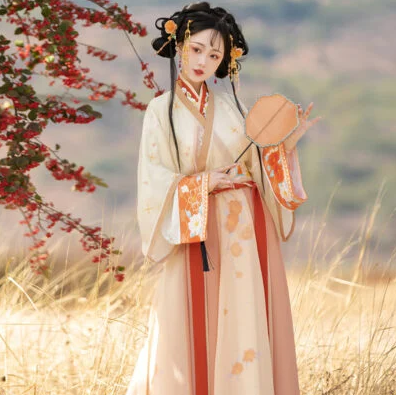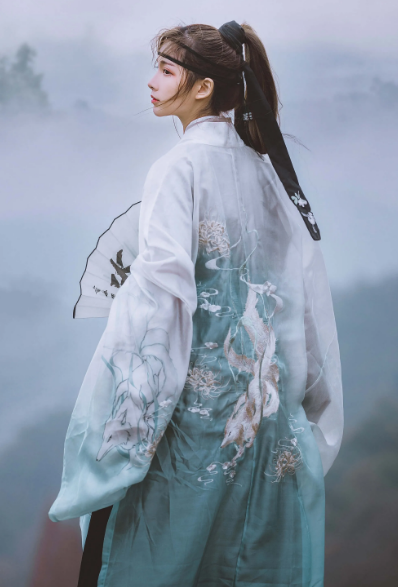Introduction
Hanfu, the traditional clothing of the Han Chinese people, traces its origins back thousands of years. This attire, more than just a fashion statement, represents a deep connection to the Han Chinese heritage and a vibrant expression of ancient aesthetics. The term “Hanfu” itself, which directly translates to “Han clothing,” offers a glimpse into the cultural identity and pride embedded within these garments.
Definition and Origin
Hanfu emerged during the Han Dynasty (206 BCE – 220 CE), a period noted for its profound cultural and political influence on China’s history. The style and design of Hanfu typically include crossed collars and robes tied with a sash. Fabrics range from silk to linen, showcasing intricate patterns and rich colors. This traditional dress takes various forms depending on factors like social status, occasion, and season.

Historical Significance in Chinese Culture
Hanfu holds a pivotal place in Chinese culture, often appearing in significant events like festivals, weddings, and religious ceremonies. It not only reflects China’s rich history but also its artistic and philosophical ideals. For centuries, Hanfu has evolved, mirroring the changes in dynastic rules, social norms, and artistic tastes. It also symbolizes the Chinese spirit and intellect, offering insights into Confucianism, Taoism, and other philosophical thought prevalent throughout Chinese history.
The Han Dynasty: Birthplace of Hanfu
The Han Dynasty stands as a monumental era in Chinese history, marking the origin and popularization of Hanfu. This period, spanning over four centuries, set the foundation for traditional Chinese clothing, deeply influencing future generations and fashion trends across East Asia.
Fashion and Aesthetics in the Han Dynasty
During the Han Dynasty, Hanfu evolved into an embodiment of elegance and simplicity, mirroring the societal values and aesthetics of the time. Men typically wore Yi, a narrow-cuffed, knee-length tunic tied with a belt, and Shang, a narrow, ankle-length skirt. Women’s Hanfu, often featured flowing sleeves and long skirts, accentuating gracefulness and femininity. The use of silk, a highly valued material, was common, and the colors often denoted social rank. The weaving and dyeing techniques of this era significantly influenced fabric quality, enhancing the overall appeal and durability of Hanfu. For more historical insights, explore the Han Dynasty on Wikipedia.
Influence on Subsequent Chinese Clothing Styles
The style and philosophy of Hanfu from the Han Dynasty significantly influenced subsequent Chinese clothing. Tang, Song, and Ming dynasties, for instance, saw adaptations and innovations in Hanfu while retaining its core principles. The layered robes of the Tang Dynasty, the right-lapel overgarment popular in the Song period, and the Ming Dynasty’s addition of various accessories demonstrate this evolution. Each dynasty added unique elements to Hanfu, reflecting the social and cultural changes of their respective eras. The enduring influence of Hanfu underscores its importance not just as clothing, but as a living relic of China’s dynamic history and rich cultural tapestry.
Cultural and Symbolic Meanings
Hanfu isn’t just clothing; it’s a rich tapestry of Chinese history and philosophy. Each aspect of Hanfu, from its colors and fabrics to its designs, carries deep cultural and symbolic meanings, reflecting the thoughts, values, and social norms of ancient China.
Representations and Symbolism in Design and Patterns
The designs and patterns in Hanfu are not merely decorative but imbued with profound symbolism. For example, the use of dragons, phoenixes, and lotus flowers often symbolizes good luck, prosperity, and purity. Colors too hold significance; red stands for happiness and good fortune, while yellow traditionally represented the emperor. These elements in Hanfu are not random but carefully chosen to convey specific messages and sentiments, deeply rooted in Chinese cosmology and mythology.
Role in Traditional Festivals and Ceremonies
Hanfu plays a central role in traditional Chinese festivals and ceremonies, enhancing the ritualistic and celebratory atmosphere. During events like the Spring Festival or the Mid-Autumn Festival, wearing Hanfu is a way to honor ancestors and embrace cultural heritage. The attire is also prominent in Confucian ceremonies, weddings, and other important life events, symbolizing respect, etiquette, and the connection to Chinese traditions. The fabric, style, and color of Hanfu worn during these occasions are often meticulously selected to align with the event’s purpose and significance, demonstrating the continuing relevance and respect for tradition in modern Chinese society. For further insights into how traditional attire plays a role in cultural festivals, Chinese festival culture offers comprehensive information.
Centuries of evolution
Hanfu has seen remarkable transformations throughout Chinese history, evolving with each dynasty’s cultural, social, and political shifts. This traditional attire, originating from the Han Dynasty, has undergone various changes, adapting to the needs, tastes, and values of different periods while retaining its distinctive identity.
Transformations from Ancient Times to the Modern Era
From its inception in the Han Dynasty, through the opulence of the Tang Dynasty, to the refined styles of the Ming and Qing Dynasties, Hanfu has mirrored the dynamism of Chinese society. For instance, the Tang Dynasty saw bolder styles with wide sleeves and vibrant colors, reflecting China’s cosmopolitanism and the influence of Silk Road trade. The Song Dynasty introduced more subdued and simpler designs, aligning with the era’s neo-Confucian ideals. In recent years, there has been a resurgence in Hanfu popularity, driven by a renewed interest in traditional culture among China’s youth. This modern Hanfu, while inspired by ancient styles, often incorporates contemporary fabrics and techniques, making it more suitable for everyday wear.
Comparisons with Other Traditional Chinese Attires
Comparing Hanfu with other traditional Chinese attires, such as the Manchu-influenced Qipao (Cheongsam), highlights distinct cultural and historical narratives. The Qipao, known for its form-fitting silhouette, originated in the 20th century and represents a blend of traditional Chinese and modern Western fashion elements. In contrast, Hanfu, with its looser fit and emphasis on flowing lines, directly links to ancient Chinese traditions. These differences in style, cut, and history not only showcase the diversity of Chinese clothing but also reflect the broader tapestry of China’s rich cultural heritage. For a deeper understanding, you can read about Traditional Chinese clothing on Wikipedia.
Hanfu in Contemporary Society
The traditional Hanfu has made a striking comeback in modern Chinese society, evolving from a historical costume to a symbol of cultural identity and fashion statement. This revival reflects a broader interest in traditional culture among China’s younger generations, inspired by a desire to reconnect with and explore their heritage.
Revival and Popularity in Modern Times
In recent years, Hanfu has seen a surge in popularity, especially among the youth. Online communities and social media platforms play a pivotal role in this resurgence, with numerous groups and pages dedicated to Hanfu fashion, showcasing various styles and occasions for wearing these traditional garments. Enthusiasts often gather at cultural events, universities, and public spaces to celebrate and promote Hanfu culture, attracting both national and international attention.

Influence on Fashion, Media, and Public Perception
The modern adaptation of Hanfu also impacts mainstream fashion and media. Designers are integrating elements of Hanfu into contemporary clothing, while TV shows and movies set in historical periods often feature elaborate Hanfu costumes, further fueling public interest. This influence extends beyond fashion into a movement for cultural appreciation, challenging perceptions and deepening the understanding of China’s past. The adaptation of Hanfu in varied forms and styles not only honors traditional aesthetics but also fits the dynamic lifestyle of the 21st century, making a profound statement about preserving heritage in a modern world. For a glimpse into the integration of tradition and modernity in Chinese fashion, click here.
Conclusion
Hanfu, more than just a traditional attire, has become a symbol of Chinese culture and identity. Its journey from the ancient dynasties to contemporary society illustrates not only the adaptability of this attire but also its enduring significance in the hearts of the Chinese people.
Hanfu’s Impact on Chinese Identity and Heritage
The resurgence of Hanfu goes beyond fashion, playing a crucial role in strengthening cultural identity and heritage among the Chinese, especially the youth. It fosters a deeper connection with the past, helping to revive and preserve traditional values and customs. This growing interest in Hanfu reflects a broader trend of looking back to history to understand and shape the present and future cultural identity of China.
Future Prospects and Continued Relevance in Culture and Fashion
Looking ahead, Hanfu’s popularity is likely to continue influencing both the fashion industry and cultural practices. As a symbol of Chinese history and aesthetics, it offers endless inspiration for contemporary designers and artists. The increasing global interest in Hanfu and Chinese culture further positions it not only as a national treasure but also as a fascinating element in the tapestry of global fashion and heritage. This ongoing evolution of ensures its relevance and vitality, as it adapts to modern times while honoring an ancient legacy. The story of Hanfu, deeply intertwined with the story of China itself, continues to unfold, promising new interpretations and celebrations of this iconic cultural emblem. To explore more about the cultural significance and future prospects of traditional clothing, consider visiting Cultural Heritage of China.







